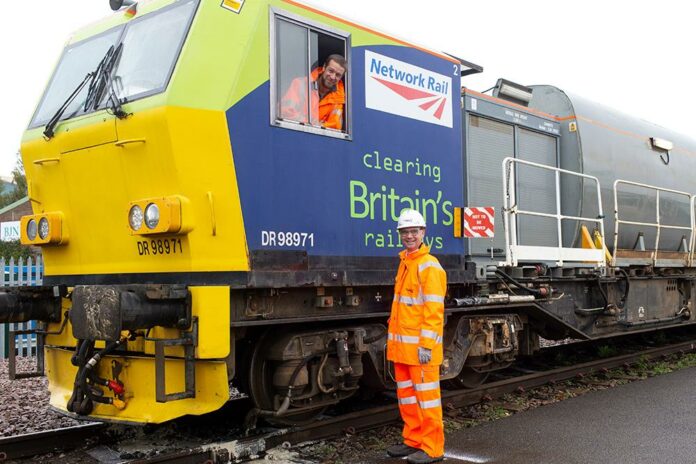Wet and windy autumns are keeping Network Rail’s Southern Region’s leaf-busting team busy keeping passengers safe and on-time as thousands of leaves fall on tracks across the area.
The company’s fleet of water jetting trains are well into their stride, on the way to running an incredible 300,000 miles this season as the company mixes brute force with technology to keep trains running. The company gets at least two weather and leaf-fall reports every day to predict conditions and uses those predictions to plan its work and where to focus efforts.
Leaves on the line are no joke, as they get crushed under train wheels and turned into a black ice-like layer*, that makes it harder for trains to grip and in extreme circumstances can stop signalling systems even knowing where trains are.
Network Rail Southern Region’s Rob Davis said: “It’s so important for our passengers to know we’re doing all we can to keep trains moving reliably for them, particularly during the COVID crisis where people need more space. We’re seeing much more wet and windy weather these days and our fleet of trains is running 24/7 to deal with the leaves that those conditions leave on the line.
“Our train fleet uses water jets to blast the rails clean, at such high pressures that if we stopped the trains from moving they would actually cut clean through the steel. We also lay a paste of gel, sand and steel filings to help trains grip and keep signalling systems working properly.
“This year they will run 300,000 miles over the Southern Region, from Weymouth to Whitstable and all points in between, and will lay almost 50,000 miles of gel on the way. We’re also continuing to manage our trees by the railway and keep the leaves from falling the first place, with an investment of £49m between now and 2024.”
As well as leaf-busting trains, Network Rail has ‘traction gel applicators’ at particularly ‘leafy’ and steep parts on the network, and its mobile teams have equipment in their vans to manually clear the railheads of leaf mulch.
James Royal, South Western Railway’s Performance Strategy Manager, said: “We know it sounds like a strange reason for delays and disruption, but leaf fall can cause dangerously slippery conditions on the railway. Our number one priority is the safety of our customers, and this autumn we are working harder than ever to keep people moving safely.
“With the help of our high-tech and immersive simulator, all our drivers are well-prepared to deal with slippery conditions, while depot teams are working flat-out to improve wheel adhesion. We have also designed our timetable specifically to take account of leaf fall and minimise any disruption.
“Working alongside Network Rail, we will continue to get a grip on autumn and ensure our customers can get to where they need to be.”
This year we are working harder than ever to overcome the challenges posed by autumn so that we can not only keep our customers moving but keep them safe too.
*When leaves are crushed, the action of compressing them creates heat, which bakes the leaves to the rails, like burning sugar onto the bottom of a pan. Leaves with high sugar contents and lots of moisture, such as oaks, create more problems than less “juicy” leaves.
Photo credit: Network Rail
For today’s rail news from railbusinessdaily.com click here.



































 0113 2082620
0113 2082620 info@railbusinessdaily.com
info@railbusinessdaily.com 15 Mariner Court, Wakefield WF4 3FL
15 Mariner Court, Wakefield WF4 3FL

